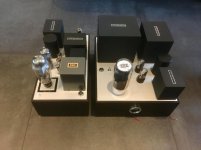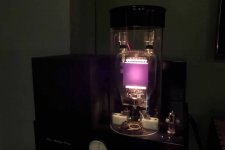Pieter = Tribute?
Ah yes - that's what I was thinking of. Thanks.
Is it possible to say something about a brand's sound? Like "Japanese brands are colored" or Monolith sounds derailed but dry, things like that. Or do you think specs are all I should think about?
Interested in your experience/opinions
These generalities tend to not be particularly consistent or helpful. The operating point and driver are going to contribute considerably to what the amp actually sounds like too.
I have nothing bad to say about Hashimoto OPTs they are great smooth sounding transformers. Since the beginning of this thread several years ago I settled on Plitron OPTs. I bought one set and invited a group over to listen because I though they sounded so good. I converted 2 other people that night, one of which that said until he heard them he didn't think much of toroids. He listened for about 15 minutes and said he never heard anything as good. When I built my second set of 300B mono blocks I bought another set. I own a 5000 ohm set and I think the others are 2500 or 3000 ohm. I can tell no difference between them.
Member
Joined 2009
Paid Member
I know, in just trying to base my decision on something more then aesthetics and brand names.
Let me put it differently; on what criteria would one make a choice, other than price.
Brand = reputation, at least as far as reducing the risk that you'll be dissatisfied with performance or service. And a good brand OPT can be re-sold more easily. Psychologically, a good brand feels nice and more likely the design (interleaving etc.) is good.
Criteria = has a gap to suit the dc current you'll be biassing the tube at, with a good margin of safety (e.g. 1.5 x what you need) to avoid non-linearities from getting close to core saturation. Thin EI laminations for reduced eddy losses, also tends to be a sign of good quality by the manufacturer. Adequate primary inductance to load the tube at low frequencies (e.g. > 10H). Non-tapped secondary windings tend to allow for more optimal windings.
[For my SET, I chose Sowter]
A 300B OPT can certainly vary in spec, though there's a "generic" model which is designed for at least 70mA current, and which goes from 2.5K to 5K with a typical mid point of 3k to 3.5K. So it is possible to make direct comparisons, do A-B tests in the same circuit, have shootouts etc. These listening tests are about the best indicator you're going to get for sound quality. There have been a number of comparative listening tests carried out by contributors to these threads and elsewhere. The problem is they compare a small sample out of a large number of different OPTs, so you have to piece together the data (almost all subjective) to get any kind of rank order.
If you look at contributors here who have tried a number of OPTs in similar circuits, the one name that seems to outperform others looks to be Monolith. They're not cheap, but clearly they deliver. In earlier times the leading names were Tamura and Tango, but the situation moves on as the best winders get older and retire. This is a business built around a small number of very talented winders, and it's good to see new names emerge and continue to give us state of the art products.
If you look at contributors here who have tried a number of OPTs in similar circuits, the one name that seems to outperform others looks to be Monolith. They're not cheap, but clearly they deliver. In earlier times the leading names were Tamura and Tango, but the situation moves on as the best winders get older and retire. This is a business built around a small number of very talented winders, and it's good to see new names emerge and continue to give us state of the art products.
+1 for Monolith Magnetics. I have a lot of their transformers (all custom) in my system, they're excellent.
+1 for the Monolith S9 3k3
Thanks for the feedback. Which' off the shelf' iron do you have? Do you have any experience with other opt's and if so, how do they compare?
The Opt in the Gm70 amplifier is Monolith S-15
http://www.monolithmagnetics.com/si...70 single ended output transformer prelim.pdf They have sleeped in a shelf for some time.... A while after I received them Monolith released a version with amorph core, tempted to compare one day... Many years ago I buildt an amplifier with 13e1 se with plate to plate feedback. The first version was with LL 1693 http://www.lundahl.se/wp-content/uploads/datasheets/1693.pdf The second version was made with a custom Sowter OPT, the third version with A custom Monolith OPT. If memory serves, all three OPT’s meassured well in the Amplifier. From the simple Meassurements I was able to do, frequency response, THD and spectrum of output, I could not say that one behaved better than the others. However they did sound different..... I regret that I did not build a test rig to switch between them. The time between Pulling one out , putting one in makes comparision difficult. Maybe this is different for other ears, but I do not trust mine when I try to remember the sound of yesterdays OPT.
Monolith S-833 in my Midlife Crisis amps. No other OPTs I know of that can deliver bandwith of 8-66kHz at 1W using the 833C with 2.3kV on the plate. That BIG black block next to the 833 is the OPT. It weighs 63lbs.
Oh, and they sound great, too.
Oh, and they sound great, too.
Attachments
Last edited:
+1 for toroidalsI have nothing bad to say about Hashimoto OPTs they are great smooth sounding transformers. Since the beginning of this thread several years ago I settled on Plitron OPTs. I bought one set and invited a group over to listen because I though they sounded so good. I converted 2 other people that night, one of which that said until he heard them he didn't think much of toroids. He listened for about 15 minutes and said he never heard anything as good. When I built my second set of 300B mono blocks I bought another set. I own a 5000 ohm set and I think the others are 2500 or 3000 ohm. I can tell no difference between them.
I use only toroidals in my amplifiers, be PP or SE or parafeed-SE. But I have a tendency to perceive good sound with good parameters, eg: in PP trafos, when have good simmetry of leakage inductance, parasitic capacitance and resistance at primary halves, allied with low parasitic values of leakage inductance and capacitance, although I don't dispute who consider the insulating material important...
Complement: of course don't need to be toroidal for being good. Various excellent examples like Magz amp are here.
But is to illustrate that people don't need to fear toroidals; sounds great. (also, I made the design of my toroidals
Amorphous C core NP acoustics i found at Nano-Audio Technology - Home Audio, Single Ended 2A3 6A3 300B
I've gone back to using a 300b output stage after years of PSE 4P1L. Currently using a LL1682/50mA which is 5.5K into 5 Ohms. I must say it sounds very nice. I'm running it at around 300v and 50mA. I've read several times about preferring a 5K OPT for the 300b, and I can see why. I don't need the 300b to run flat out and maybe that helps.
- Home
- Amplifiers
- Tubes / Valves
- Best 300B SE OPT?

